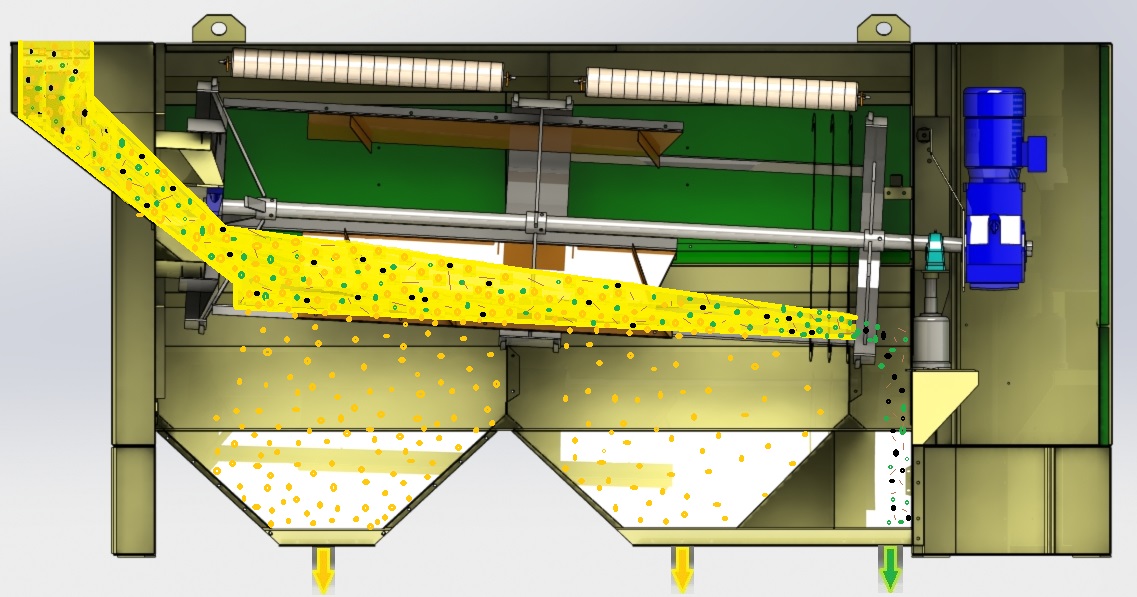 |
Emile MAROT Pre-cleaners simply and quickly remove large particles contained in the grain. The grain enters the rotating drum whose perforations allow the grain to pass through while retaining the large-size waste which exits from the bottom of the drum. Pre-cleaners are essential for the correct operation of dryers to avoid them fouling up and prevent energy wastage. The choice of perforations is made according to the nature of the grain to be worked, its humidity levels and the properties of the waste to be removed. The initial grids can be used, if necessary to remove small-size waste products. The large surface areas of the grids whose perforations are continually cleared enable flow rates of 35 to 400 tonnes per hour. The following table summarizes possible equipment combinations: Dust removers on Grid pre-cleaners, Pre-cleaners on dust removers or suction cleaners on pre-cleaners |
| PRE-CLEANERS / MODELS | PN601 |
PN1002 |
PN1253 |
PN1503 |
PN2004 |
PN3003 |
PN4004 |
| Flow rate (t/h) | 35 |
60 |
90 |
200 |
250 |
250 |
400 |
| Nb of grids | 1 |
2 |
3 |
3 |
4 |
3 |
4 |
| Siev diam | 805 |
805 |
805 |
1260 |
1260 |
1610 |
1610 |
| Grid area(m²) | 2,50 |
5 |
7,5 |
12 |
16 |
15 |
20 |
| Power(KW) | 1,5 |
1,5 |
1,5 |
4 |
4 |
11 |
11 |
| Lengh (mm) | 2420 |
3570 |
4720 |
4955 |
6105 |
5231 |
6381 |
| Width(mm) | 1120 |
1120 |
1120 |
1700 |
1700 |
2000 |
2000 |
| Height (mm) | 1660 |
1660 |
1660 |
2175 |
2175 |
2500 |
2500 |
| Weight empty (kg) | 640 |
770 |
960 |
2010 |
2260 |
3300 |
4000 |
| Flow rates for pre-cleaning maize with 35% humidity | |||||||
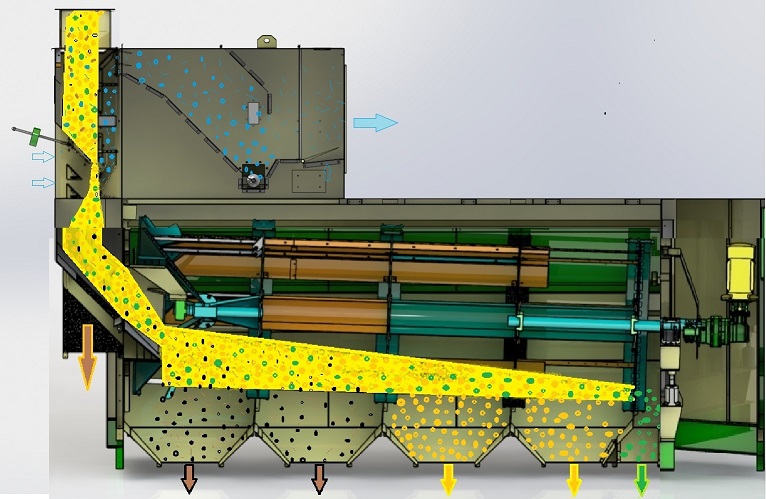 |
EACs remove lightweight products and separate broken kernels and large-size waste from the good grain. These operations are carried out by double-acting suction followed by a rotating drum. The raw product is spread out in a uniform layer and a current of air blows through it. The proportion of lightweight products driven off is altered by adjusting the suction power. The heaviest particles settle in the holding chamber and are extracted by a screw. Lightweight particles are expelled (V) by suction. A direct output P enables the work to be stopped there if desired. The grain then flows into a rotating drum with interchangeable grids. The first of these remove broken kernels and those following let the good grain pass through. The largest elements exit from the bottom of the drum. The succession of grids with different perforations make these devices remarkably useful for all types of grain, at flow rates from 5 to 400 tonnes/hour. |
| CLEANERS / MODELS | Flow rate (t/h) |
Nb of grids |
Drum diam (mm) |
|
| EAC 53 | 5 |
3 |
460 |
|
| EAC 153 | 15 |
3 |
630 |
|
| EAC 354 | 25 |
4 |
630 |
|
| EAC 503 | 50 |
3 |
805 |
|
| EAC 704 | 70 |
4 |
805 |
|
| EAC 1103 | 130 |
3 |
1260 |
|
| EAC 2004 | 200 |
4 |
1260 |
|
| EAC 2505 | 250 |
5 |
1260 |
|
| EAC 3003 | 220 |
3 |
1610 |
|
| A4010 / C4.1610 | 300 |
4 |
1610 |
|
| A4010 / C5.1610 | 400 |
5 |
1610 |
|
Flow rates for wheat PS 0.75 with 2% impurities. |
||||
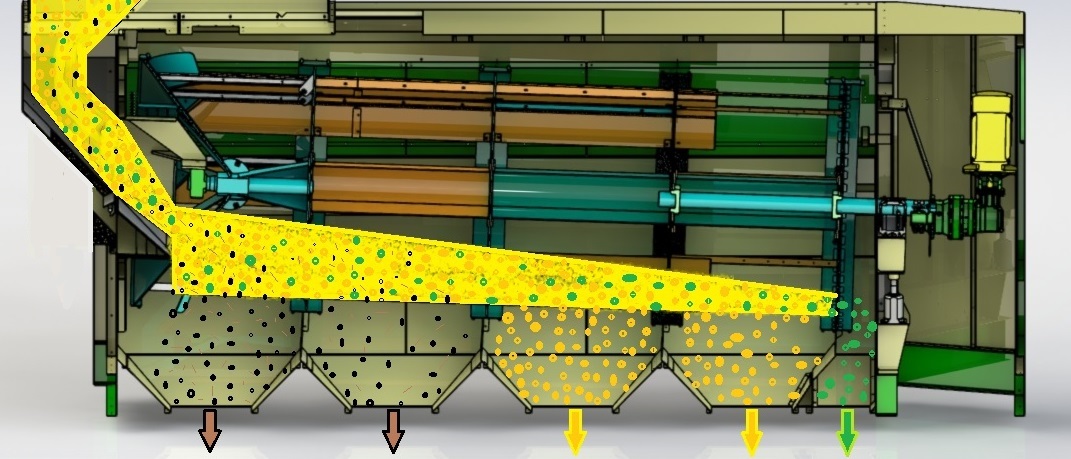 |
Emile MAROT Graders separate grains depending on their size. The precision of the sorting process is obtained by means of a rotating drum whose angle and rotation speed can be changed. The device is chosen according to the number of products and flow rate desired. The first criterion determines the number of sections required (3 to 5) and the second, the diameter of the drum (630 to 1,610 mm). When the number of grain categories which must be obtained is very high, as for coffee, grading is achieved using a combination of modular devices. |
| GRADERS / MODELS | Flow rate (t/h) |
Nb of grids |
drum diam (mm) |
Grid area (m²) |
Power (kW) |
Weight (kg) |
|
| 3/630 | 3 |
3 |
630 |
3.9 |
0.75 |
435 |
|
| 4/630 | 4 |
4 |
630 |
5.1 |
0.75 |
520 |
|
| 5/630 | 6 |
5 |
630 |
6.4 |
0.75 |
605 |
|
| 3/805 | 10 |
3 |
805 |
7.5 |
1.5 |
960 |
|
| 4/805 | 14 |
4 |
808 |
10 |
1.5 |
1170 |
|
| 5/805 | 18 |
5 |
805 |
12.5 |
1.5 |
1380 |
|
| 3/1260 | 20 |
3 |
1260 |
12 |
4 |
2010 |
|
| 4/1260 | 30 |
4 |
1260 |
16 |
4 |
2260 |
|
| 5/1260 | 40 |
5 |
1260 |
20 |
5.5 |
2510 |
|
| 3/1610 | 35 |
3 |
1610 |
15 |
11 |
3300 |
|
| 4/1610 | 45 |
4 |
1610 |
20 |
11 |
4000 |
|
| 5/1610 | 60 |
5 |
1610 |
25 |
15 |
4700 |
|
Flow rates for barley at 75% humidity
|
|||||||
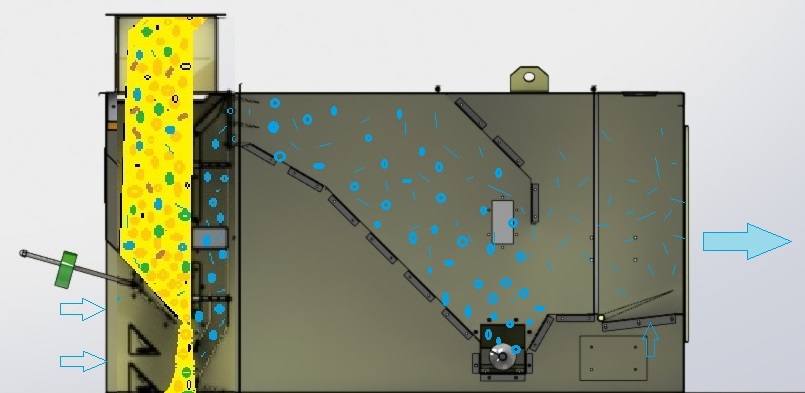 |
The Suction cleaners are used to remove the grain and the light waste it contains whilst retaining the heaviest products for subsequent retrieval. They are used alone or in association with a grid pre-cleaner or a trash catcher. The grain, introduced into the device by feed hopper G, emerges as a uniform sheet by means of an adjustable shutter. A current of air blows through the sheet removing lightweight products. A distributor adjusted by a thumb-wheel ensures straw products are regularly removed. The heaviest products fall into a holding chamber and are removed by screw M while the others are ejected. These pre-cleaners are compact and integrate very easily into reception systems without limiting their flow rate: 70 to 500 tonnes per hour. |
| SUCTIONS / MODELS | Flow rate (t/h) |
Cleaning (t/h) |
Suction (m3/h) |
Power (kW) |
Length (mm) |
Width (mm) |
Height (mm) |
Vol (m3) |
Weight (kg) |
| A 350 | 45 |
40 |
6000 |
2.2 |
2120 |
1295 |
1290 |
3.5 |
250 |
| A 510 | 90 |
70 |
6000 |
3 |
2590 |
1490 |
1685 |
6.5 |
350 |
| A 2010 | 250 |
200 |
12000 |
0.5+7.5 |
2635 |
2300 |
2745 |
13.6 |
660 |
| A 3010 | 300 |
250 |
16000 |
0.5+10 |
2914 |
2700 |
2745 |
21.6 |
980 |
| A 4010 | 500 |
400 |
22000 |
0.5+22 |
3185 |
2595 |
2855 |
23.6 |
1220 |
Flow rates for wheat PS 0.75 with 2% impurities
|
|||||||||
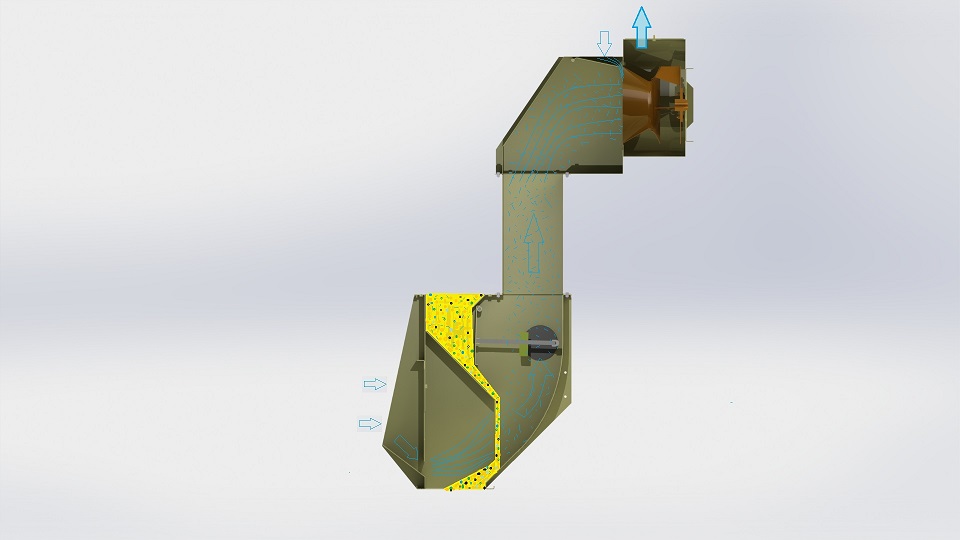 |
Emile MAROT Dust removers are particularly useful for simple particle removal. The grain is laid out in a uniform layer by a counter-weighted hatch, then a current of air is blown through it. The proportion of light waste extracted is adjusted by setting the suction power and the additional air intake shutter situated on the upper casing. These dust removers may be easily used anywhere in the handling circuits due to their small size. |
| DUST REMOVERS / MODELS | Flow rate (t/h) |
Suction (m3) |
POWER (kW) |
|
| BD 600 | 60 |
2700 |
1.5 |
|
| BD 1000 | 100 |
6000 |
3 |
|
| BD 2000 | 180 |
12000 |
7.5 |
|
Flow rates for wheat PS 0.75 at 16% humidity with 2% impurities |
||||
| Mentions légales : © 2014 CFCAI |